There’s an unspoken trust we place in our knees: the trust to carry us through marathons, dance parties, and even those rushed mornings when we’re late for work. But when that familiar and sharp pain strikes the front of our knee, it feels like a betrayal. Why does this pain emerge, often seemingly out of the blue? Is it a fleeting ache or a sign of something more serious? If you’ve ever wondered, “Why does the front of my knee hurt?“, you’re not alone. This guide dives deep into the causes of anterior knee pain and, more importantly, offers actionable insights to help you stride forward with confidence once again.
Contents
What Are The Causes Behind Anterior Knee Pain?

Anterior knee pain, often described as discomfort or a throbbing sensation at the front of the knee, can stem from various factors. While the sensation is common, particularly among active individuals, understanding the underlying causes is crucial to managing and treating the pain effectively. Here are some prevalent reasons:
Patellofemoral Pain Syndrome (PFPS)
Commonly termed “runner’s knee,” PFPS arises when the cartilage under the kneecap becomes damaged or worn out. This causes pain and discomfort in the front of the knee, especially when sitting for long periods, squatting, or going up and down stairs.
Quadriceps Tendonitis
The quadriceps tendon connects the thigh’s quadriceps muscles to the patella (kneecap). Overuse or strain can inflame this tendon, leading to pain at the front of the knee, particularly during activities that put stress on the knees, such as jumping or lunging.
Patellar Tendinitis (Jumper’s Knee)
This condition is the inflammation or injury of the patellar tendon, the cord-like tissue that connects the patella to the shinbone. It’s common among athletes who frequently jump, hence the name “Jumper’s Knee.”
Chondromalacia Patella
This condition refers to the softening and subsequent breakdown of the cartilage on the underside of the kneecap. It can cause a grinding sensation and pain in the front part of the knee.
Osgood-Schlatter Disease
Typically seen in growing adolescents, this condition is characterized by a painful lump below the kneecap. It occurs when the patellar tendon pulls on the growth plate at the front of the shinbone.
Trauma or Injury
Direct blows to the front of the knee, such as from a fall or collision, can lead to pain in the anterior region. This could be due to bone bruising, fractures, or injuries to the ligaments or tendons in the area.
Overuse
Engaging in repetitive activities, especially without proper training or equipment, can strain the muscles and tendons around the knee, causing anterior knee pain over time.
While these are some of the typical causes, it’s essential to recognize that every individual’s anatomy and experience are unique. Sometimes, factors like poor footwear, misalignment in the leg or foot, or even inadequate core strength can contribute to or exacerbate anterior knee pain. Understanding the root cause of the pain is the first step towards effective treatment and management.
Role of Physical Activities in Anterior Knee Pain
 When it comes to our knees, especially the anterior or front part, physical activities play a pivotal role in determining overall health and comfort levels. Engaging in sports, exercises, or even daily activities can sometimes trigger anterior knee pain.
When it comes to our knees, especially the anterior or front part, physical activities play a pivotal role in determining overall health and comfort levels. Engaging in sports, exercises, or even daily activities can sometimes trigger anterior knee pain.
- One of the most common culprits behind anterior knee pain is RUNNING, especially when done on hard surfaces or without proper footwear. Additionally, incorrect running mechanics, like overpronation, can place extra stress on the knee joint.
- Activities that involve frequent jumping, such as basketball or volleyball, exert significant force on the knees. This force can lead to conditions like patellar tendinitis, aptly named “Jumper’s Knee.”
- While often recommended as a low-impact exercise, cycling can be hard on the knees if the bike setup is not correct. An improperly adjusted saddle height or pedal position can strain the knee, especially the anterior region.
- Going up or, more commonly, down stairs, puts a lot of pressure on the kneecap. Those already experiencing anterior knee pain might find stairs particularly challenging and painful.
- Ironically termed the “theater sign” or “movie-goer’s knee,” prolonged sitting can cause stiffness and pain in the front of the knee.
While these activities can contribute to anterior knee pain, it’s essential to understand that they aren’t inherently “bad.” Sometimes, making slight adjustments, like changing running surfaces, altering bike setups, or tweaking exercise techniques, can make a world of difference.
Conservative Management Techniques at Home
 While seeking professional advice for persistent or severe anterior knee pain is crucial, there are several conservative management techniques you can employ at home to alleviate discomfort. Implementing these strategies can provide relief and act as a first line of defense against knee pain:
While seeking professional advice for persistent or severe anterior knee pain is crucial, there are several conservative management techniques you can employ at home to alleviate discomfort. Implementing these strategies can provide relief and act as a first line of defense against knee pain:
- Rest: Give your knee a break. Avoid activities that exacerbate the pain and let the affected area heal.
- Ice: Apply cold packs to the painful area for 15-20 minutes at a time, several times a day. Make sure to have a cloth or barrier between the ice and your skin to prevent frostbite.
- Compression: Using an elastic bandage or compression sleeve can help reduce swelling and provide support.
- Elevation: Prop your leg up on pillows or cushions to help decrease swelling. Ideally, try to elevate the leg above the level of the heart.
- Over-the-counter Pain Relievers: Non-prescription medications like ibuprofen or naproxen can help reduce pain and inflammation. Always consult with a healthcare provider before starting any medication regimen to ensure it’s safe and appropriate for you.
- Proper Footwear: Wearing supportive shoes that provide cushioning and fit well is essential. Consider orthotic insoles if you have specific foot biomechanics that might be contributing to your knee pain. Always avoid wearing worn-out shoes, especially during physical activities.
- Gentle Stretching: Regularly stretching the muscles around the knee, such as the quadriceps, hamstrings, and calf muscles, can provide relief and prevent tightness that might exacerbate the pain.
- Knee Braces or Sleeves: These can provide added support, especially when you know you’ll be engaging in activities that usually trigger your pain. They can offer compression, warmth, and stability.
Remember, while these at-home remedies can provide relief, they should not replace a thorough evaluation and diagnosis by a healthcare professional. If your pain is persistent, worsening, or accompanied by other concerning symptoms, it’s essential to consult with a specialist to understand the underlying cause better and receive tailored treatment recommendations.
Targeted Exercises and Stretches For Anterior Knee Pain Relief
Including specific exercises and stretches into your routine can be incredibly effective for both alleviating anterior knee pain and strengthening the muscles that support your knee. Here’s a list of exercises and stretches that can help:
Quadriceps Stretch
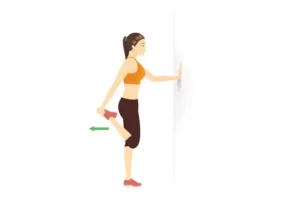
- How to do it:
- Stand upright next to a wall or a sturdy object for balance.
- Bend one knee, bringing your heel towards your buttock.
- Hold your ankle with the hand on the same side.
- Gently pull your heel closer to your buttocks while keeping your knees together and pushing your hips forward.
- Hold for 20-30 seconds and repeat on the other side.
Hamstring Stretch

- How to do it:
- Sit on the floor with one leg straight and the other bent, so the sole of your foot is against the inner thigh of your straightened leg.
- Lean forward from your hips towards the toes of your straightened leg while keeping your back straight.
- Hold for 20-30 seconds and switch legs.
Straight Leg Raise
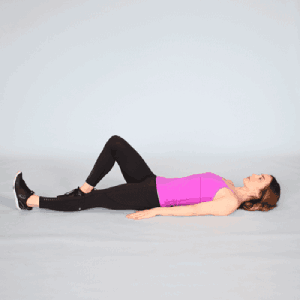
- How to do it:
- Lie on your back with one leg bent and the other straight.
- Tighten the thigh muscles of your straight leg and raise it to the height of the bent knee.
- Lower slowly and repeat. Switch legs after completing the set.
Wall Sit

- How to do it:
- Stand with your back against a wall.
- Slowly slide down the wall until you are in a seated position, knees at a 90-degree angle.
- Hold the position for as long as you can, aiming for 20-30 seconds to start and gradually increasing the time as your strength improves.
Step-ups
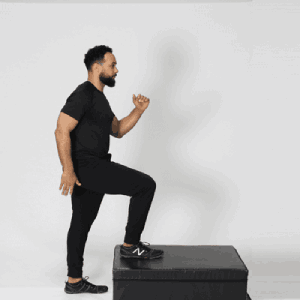
- How to do it:
- Using a low step or bench, place one foot on the step.
- Push through your heel to lift your body onto the step, bringing the other foot to join it.
- Step down and repeat, alternating legs.
Clamshells
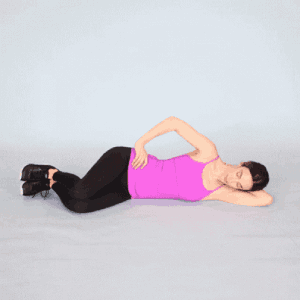
- How to do it:
- Lie on your side with your hips and knees bent at a 90-degree angle, legs stacked.
- Keeping your feet touching, lift your top knee as high as you can without shifting your hips.
- Slowly lower your knee back down. Repeat on both sides.
IT Band Stretch

- How to do it:
- Stand tall, and cross your right leg behind your left leg.
- Lean slightly forward to your left side until you feel a stretch on the outside of your right leg.
- Hold for 20-30 seconds and switch sides.
Advanced Treatments and Interventions
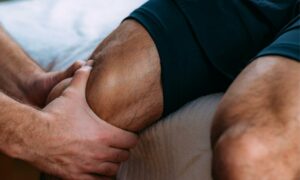 For those who find conservative methods insufficient, advanced treatments can provide significant relief from anterior knee pain. Platelet-rich plasma (PRP) injections harness the body’s healing abilities, accelerating recovery by introducing concentrated platelets to the affected area.
For those who find conservative methods insufficient, advanced treatments can provide significant relief from anterior knee pain. Platelet-rich plasma (PRP) injections harness the body’s healing abilities, accelerating recovery by introducing concentrated platelets to the affected area.
Arthroscopy is a minimally invasive surgical procedure that allows doctors to view and treat knee joint issues directly.
Additionally, physical therapy often plays a crucial role, using specialized techniques and exercises to reduce pain and restore function.
Lastly, when other treatments fail, knee braces or orthotics can offer the needed support and alignment correction. Always consult with an orthopedic specialist before opting for any advanced intervention.
Conclusion
Anterior knee pain can be a limiting and frustrating experience, affecting everything from daily tasks to athletic pursuits. Yet, with understanding, proactive management, and the right interventions, relief is within reach. Remember, your body is a resilient mechanism, and with the right care, you can find your way back to pain-free mobility. If you’re experiencing Knee pain, physical therapy for knee pain at PhysioMantra can help: Book an online physical therapy session.



